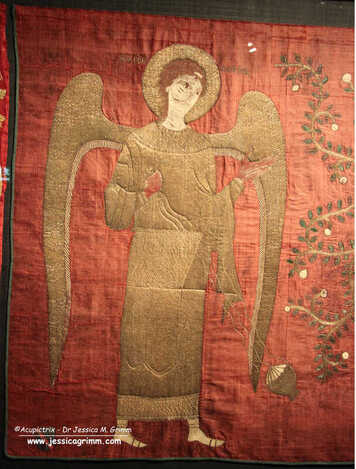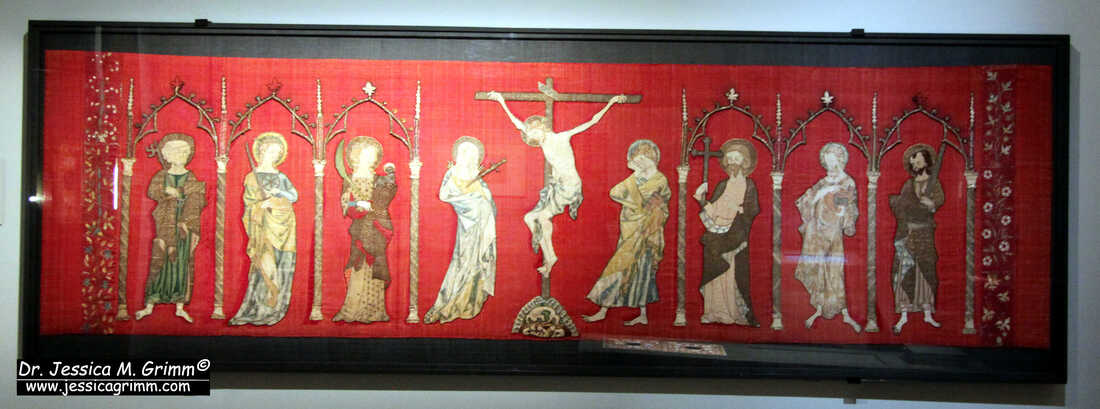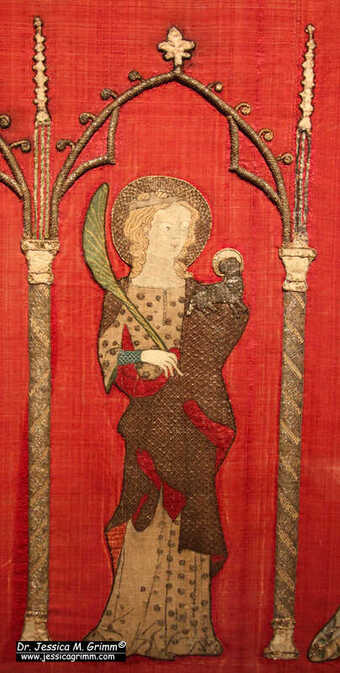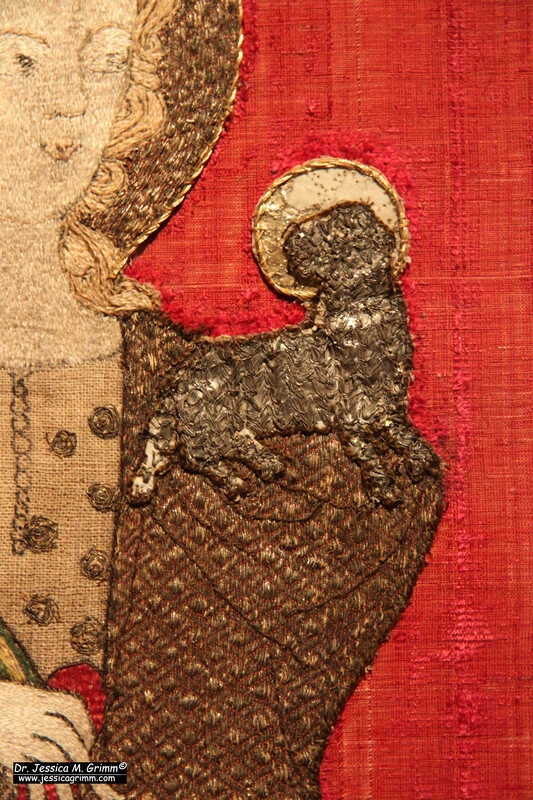|
Before I'll begin my summerly blog break until the 5th of September, I have some exciting news to share with you: The Medieval Embroidery Study Group is now open to all Patrons of the Master tier! With the exception of August, we will meet each month for a lecture and subsequent Q&A. We will meet via Zoom and the meetings are recorded and made available as part of your Master subscription. Each lecture will be about a piece of medieval embroidery I have seen in a museum. You will already be broadly familiar with the piece as it will have been featured in a blog post shortly before. This enables you to come up with questions for the Q&A. Even when you cannot attend live, you are very welcome to submit your question. Upcoming Zoom meetings will be announced on Patreon and in my newsletter. All current Patrons already have access to the recording of the Königsfelden Antependia of last Sunday. Zoom meetings will be on Saturday or Sunday evenings 19h CE(S)T. The next meeting of the Medieval Embroidery Study Group will be on Saturday evening the 23rd of September at 19h CEST. We will explore the Grandson antependium held at the Historischen Museum Bern. The parts of the antependium date to the last quarter of the 13th century and the first quarter of the 14th century. It combines surface couching with underside couching. A very interesting piece indeed!
Have a lovely summer and see you on the blog, and hopefully, in the Medieval Embroidery Study Group lectures in September!
2 Comments
One of the reasons for writing my weekly blog is to introduce you to medieval embroidered pieces that are in collections outside the UK and the US. Due to the language barrier, these pieces are often hardly known in the English-speaking world. This has led to such strange ideas as "stumpwork was invented in 17th century England" and "Opus anglicanum was only practised in England". Sorry to disappoint you, but both assumptions are wrong. One such collection is in the Bernisches Historisches Museum in Switzerland. A couple of weeks ago, we looked at an Antependium made in Vienna for Königsfelden Abbey. Today, I'll introduce you to another embroidered antependium from the same Abbey. It is very different from the first. The above antependium or altar cloth measures about 3.18 m x 0.90 m. The background fabric is probably not original. The embroidered figures are about 60 cm in height. In the middle, we see the crucifixion with Mary and St John on either side. These figures were likely embroidered in the Upper Rhine area. The other figures (St Peter, St Catherine and St Agnes on the left and St Andrew, John the Baptist and St Paul on the right) were probably embroidered in Königsfelden Abbey. How do we know? The padding material in the embroidery is parchment. During an extensive restoration in 1889, some of the parchment was removed from the back of the figures. Besides a cut-up breviary, they also found the remains of a letter between Queen Agnes of Hungary and Emperor Ludwig of Bavaria. Clever historical research by Jacob Stammler, later bishop of Basel, revealed that this letter was written between 20 October AD 1334 and 20 October AD 1335. The fact that a trivial letter to Queen Agnes was used to pad parts of the embroidery indicates that the embroidery was executed where she resided: Königsfelden Abbey. The style of the figures points to c. AD 1350 as the date for the embroidery. Personally, I quite like to read 19th century papers on medieval embroidery. I love the tone (scholarship with a splash of Ivanhoe) and the beautiful technical drawings. Quite often, the embroidery was better preserved over a 100 years ago and the drawings clearly show that. However, there is a caveat: research marches on. The aforementioned bishop Jacob Stammler was quite convinced that Queen Agnes herself professionally embroidered and was quite capable to produce an altar cloth such as the one shown in an earlier blog post. After all, her biographer said that she was proficient with the needle! Nowadays, we know that these (former) queens were far too busy to embroider professionally. With all the diplomacy they conducted for their families and the overseeing of the royal household, they were probably as busy as any female CEO is today. Good luck embroidering professionally at the same time ... So, who did embroider the additional figures on this second antependium used at Königsfelden Abbey? As Queen Agnes resided at (near?) the abbey for many years and was very active in international diplomacy with many visitors and envoys coming to see her, she basically set up court there. It is thus likely that she had a royal workshop as well. The embroidery on this second antependium is of far too high quality to have been worked by part-time embroidering nuns. This is the work of professionals. The fact that the saints chosen to accompany the central crucifixion scene have a relationship with Queen Agnes and her family (St Andrew for her late husband and St Catherine for several female relations) shows that she was, however, actively involved in choosing the design. If you would like to read the original paper by Jacob Stammler, you can find it here. As it is written in Fraktur, I've prepared a transcript and a translation for my Journeyman and Master Patrons.
|
Want to keep up with my embroidery adventures? Sign up for my weekly Newsletter to get notified of new blogs, courses and workshops!
Liked my blog? Please consider making a donation or becoming a Patron so that I can keep up the good work and my blog ad-free!
Categories
All
Archives
July 2024
|
Contact: info(at)jessicagrimm.com
Copyright Dr Jessica M. Grimm - Mandlweg 3, 82488 Ettal, Deutschland - +49(0)8822 2782219 (Monday, Tuesday, Friday & Saturday 9.00-17.00 CET)
Impressum - Legal Notice - Datenschutzerklärung - Privacy Policy - Webshop ABG - Widerrufsrecht - Disclaimer
Copyright Dr Jessica M. Grimm - Mandlweg 3, 82488 Ettal, Deutschland - +49(0)8822 2782219 (Monday, Tuesday, Friday & Saturday 9.00-17.00 CET)
Impressum - Legal Notice - Datenschutzerklärung - Privacy Policy - Webshop ABG - Widerrufsrecht - Disclaimer











 RSS Feed
RSS Feed